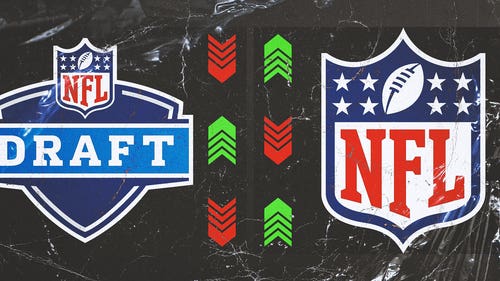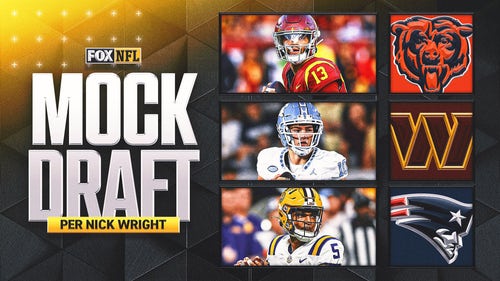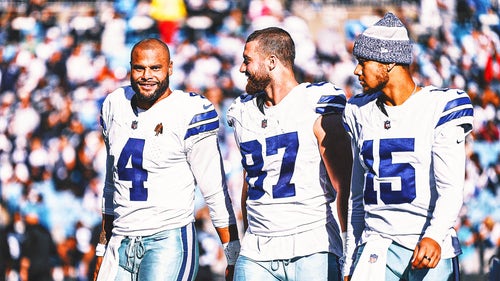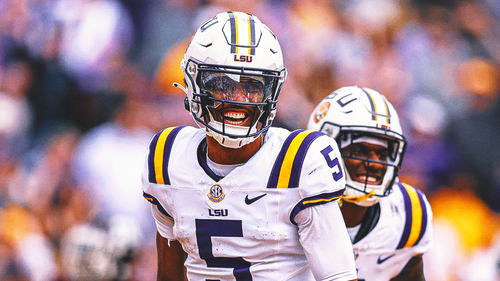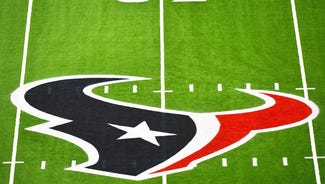
Billick on defensive lineman prospects
Da'Quan Bowers | Robert Quinn | J.J. Watt | Nick Fairley | Marcell Dareus | Aldon Smith | Ryan Kerrigan | Cameron Jordan | Stephen Paea | Phil Taylor
How good is Da'Quan Bowers?
Rated by many as the best defensive end in this year's draft, Da'Quan Bowers led the NCAA with 15.5 sacks and won the Nagurski Award as the top defensive player.
He also had the second most tackle for loss with 26, a Clemson record for defensive lineman.
Bowers measured 6-foot-3 and 280 pounds at the NFL Scouting Combine. He completed 22 repetitions in the bench press. Bowers did not compete in the running drills because of a tear in his miniscus.
When you evaluate his performance at Clemson, you see an athlete that plays a lot stronger than his 22 repetitions would suggest. He has an aggressive bull rush off the edge that violently stuns the offensive tackle and gets him off balance. Although he doesn't have elite quickness on the snap, he will be able to work on his timing and explosion off the ball with his position coach in the NFL.
Bowers is also very stout against the run, which is rare for an elite pass rusher. He stays strong as the line of scrimmage and sheds blocks without giving any ground at the point of attack. Bowers plays with great leverage and holds up surprisingly well against double teams.
Many of the records Bowers broke at Clemson where that of a previous first-round selection, Gaines Adams, Bowers' mentor and close friend.
Quinn could be elite player
Robert Quinn is another defensive end who is drawing a lot of attention as the potential No. 1 draft pick.
When watching Quinn, one thing stands out more than anything else ... his ability to use his hip movement, dip under and turn the corner when rushing the passer. Often lineman struggle to even get a hand on him, let alone an adequate punch.
To make him an elite pass rusher in the NFL, he will want to develop an array of moves, rather than just rely purely on his speed rush technique. Even Dwight Freeney can't use his patented spin move on every single play!
Quinn is different than Bowers in the fact that he is a pure pass rusher that struggles to hold up against the run. Because of that, NFL teams may have an opportunity to scheme against him and run to his side of the field — taking advantage of the running lanes he creates by rushing hard outside.
Keep in mind that all of this observation comes from his sophomore year! Having been suspended his entire junior year for receiving travel accommodations and jewelry, makes him a very tricky evaluation.
He reported to the NFL Scouting Combine at 6-foot-4, 265 pounds. He ran a 4.7 40, completed 22 bench press repetitions, jumped a 34-inch vertical and a 9-foot-8 broad jump.
I see him going in the top 10, but not before Bowers, Marcell Dareus, and Nick Fairley. When a team does select him, they will get an impressive young athlete who very easily could mature into an elite NFL player.
Defensive end gains momentum
J.J. Watt is a defensive end prospect who is gaining a lot of momentum going into April's draft.
J.J. has always been considered a top-five defensive end is this year's class, but recently some experts are now considering him a top-10 overall pick.
I have him ranked as my third best defensive end behind Quinn and Bowers, but he differs slightly in overall skill set. While Quinn and Bowers both play a traditional positions in a 4-3 defense, Watt will give his team versatility both inside and outside. I see him being most impactful as a five-technique in a 3-4 defense.
Questions about Fairley
It is safe to say that Nick Fairley was as important to Auburn as was Cam Newton. He was a game changer on the defensive line that had the ability to take over games, as shown in the BCS National Championship Game.
Last year, he registered 11.5 sacks and 24 tackles for loss, an Auburn record. Those are very impressive numbers, but they don't carry through his entire college career.
In 2009, he accounted for only 1.5 sacks and 14 total tackles. When you see numbers like that, you question personal drive, work ethic, passion for the game, maturity, etc. Teams will address, or already have, those concerns during personal workouts and interviews leading up to the draft.
When watching Fairley, you see a defensive tackle that is not limited to a specific gap or technique. Fairley has the unique ability to line up anywhere along the front, regardless of scheme and be a playmaker. He could play inside in a 4-3, five technique in a 3-4, or even play the nose on any given down making it very difficult for the offense to prepare for him in the week leading up to the game.
He has a tendency to get a little high and loses his center of gravity and base. In college, he made up for it with extremely quick feet and great hands. He slaps off the blockers hands and gets "skinny" through the hole to be a presence in the pass rush game. He shows more flexibility and quickness than he does overall power.
Dareus a Top-3 pick
At 6-foot-3 7/8 and 291 pounds, Fairley will be evaluated against Alabama's Marcell Dareus as the best defensive tackle. At this point in time, I would give a slight advantage to Dareus.
Checking in at 6-foot-3 1/8 and 319 pounds is Marcell Dareus from Alabama. I have him ranked as my top interior defensive lineman in April's draft.
Dareus provides a different skill set than Nick Fairley, being that he is more of a space-eating, run-stuffing, traditional defensive tackle than he is a big time playmaker.
Dareus will most likely play the nose in a 3-4 defense and his main role will be to keep offensive lineman from getting to the second level, freeing up his linebackers make all the plays.
He plays low and stout with a heavy anchor. He uses his arms to lock out and shed blockers to disengage and slide in the direction of the ball carrier. Once broken free, Dareus doesn't have very good closing speed, but he plugs up the holes in the middle of the field and forces running backs to run around him. He plays with more overall strength than his 24 repetitions in the bench press suggest.
Not withstanding a player boycott, Dareus won't be in the green room very long on draft day, as I look for his name to be called within the first three picks.
Mizzou LB Smith is a high-end prospect
Missouri linebacker Aldon Smith reminds me of John Abraham of the Atlanta Falcons. Right now, he is a hybrid OLB/DE, but I believe he will be better off adding a couple of pounds and becoming a full-time defensive end.
He is a raw talent that is still learning the game, but his 17 sacks in 23 games make him an attractive prospect.
Smith had a more statistically impressive 2009 season with 11.5 sacks and 46 tackles. Smith uses his length in the pass rush game to interrupt passing lanes and hold off lineman trying to get into his chest. He has the agility to keep his feet when opponents attempt to cut block him and shuffles down the line to stay involved in the play.
Even with his 17 career sacks, Smith did not just play a "sick-em" role for Mizzou's defense. He stayed stout in the run game and often took on pulling guards to clog up the hole. He shows good awareness and a feel for where the ball is at all times — which is scary considering he is coming out as redshirt sophomore.
In the game against Oklahoma, Smith displayed his overall athleticism when he intercepted a pass and returned it 58 yards.
With an early run on defensive lineman in this year's draft, look for Smith to go anywhere between 10-20 overall.
Teams will find a place for Purdue's Kerrigan
Purdue defensive end Ryan Kerrigan is quickly becoming a hot name in this year's draft, and rightly so. Last year for the Boilermakers, Kerrigan led all FBS players with 26 tackles for loss, second with five forced fumbles and third with 12.5 sacks. Kerrigan was the teams captain and defensive MVP.
At the NFL Scouting Combine, he measured in at 6-foot-3 7/8 and 267 pounds while doing 31 reps in the bench press and running a 4.71 40-yard dash. With those workout numbers and his production on the field, Kerrigan is poised to become a first round draft pick.
On tape Kerrigan shows a motor that never quits — chasing down plays from behind and hustling through the whistle. That hustle shows up in his secondary rush in which he still gets to the quarterback after initially being held up at the line of scrimmage.
He isn't an elite quick twitch guy, but he consistently plays with great leverage and strength. He understands his assignments and plays within his role on the defense. Kerrigan could improve of his overall flexibility as he does appear to be a little stiff in the hips.
Kerrigan is a natural 4-3 defensive end, but his athletic and playmaking ability has teams considering him as a 3-4 OLB as well. Defensive end makes most sense, but you can always find a place for an intelligent playmaker such as Kerrigan.
Cam Jordan will transition well into next level
California defensive lineman Cameron Jordan is an interesting prospect that NFL scouts will not have to anticipate how he will adapt as a 5-technique in a 3-4 scheme. He has been playing that role for four years in Berkeley, and that is rare to find in the college game.
Cameron took advantage of his time at the Senior Bowl. Cameron stood out in the game, and maybe even more importantly during the drills at practice.
He consistently beat the opposition in one-on-one pass rush drills with an array of pass rush moves including swim, rip, spin and bull rush. During the week at the Senior Bowl, Jordan may very well have played his way into a late first round selection.
On tape, Jordan relies on his technique and overall power to control the line of scrimmage. He not only held up blockers, but also made plays of his own even after the departure of Tyson Alualu (last year's surprise draft pick of the Jacksonville Jaguars).
Like Kerrigan, Jordan is a high energy player that plays with a great motor. He played in 50 of 51 total games at California which will provide consistency through durability for his future team.
Jordan knows what it takes to play in the NFL as his father, Steve Jordan, was a six-time Pro Bowl tight end, whom I had the pleasure of coaching in Minnesota.
Stephen Paea has raw talent but is still learning
Stephen Paea opened a lot of eyes when he threw up 49 repetitions in the bench press at last months NFL Combine. But when you evaluate him as a player, you see much more than just a olympic worthy weight lifter.
Paea has been a consistent performer during his college career at Oregon State.
He had five, three and six sacks in 2008, 2009 and 2010. In addition, he had at least one tackle for loss in 12 of the last 18 games and holds the school record with nine forced fumbles.
Keep in mind, Paea is still learning how to play the game — he didn't start playing football until his senior year of high school.
I was looking forward to watching Paea participate at the Senior Bowl, but he injured his knee in the first practice and was unable to go the rest of the week.
Paea's main role at Oregon State was to be a space-eating, run-plugging squatty body.
Compared to Nick Fairley, he wasn't asked to provide an intimidating pass rush. What he did do was collapse the pocket and forced the quarterback outside the tackle box on multiple occasions.
Whenever you have a player that can provide an inside push, it is going to make your rush ends that much more impactful as they turn the corner. For Paea to take his game to the next level, he will need to combine that low and hard initial burst with an increased ability to change direction. For now, he is just a powerful straight ahead player.
Baylor DT fits primarily as a nose tackle
Baylor defensive tackle Phil Taylor was relatively unknown nationally before his coming out party at the Senior Bowl. Taylor originally played for Penn State before being arrested following a fight at a fraternity party in 2008.
Taylor was subsequently suspended and dismissed from the team, and then decided to transfer to Baylor where he became a full-time starter in 2010.
Phil Taylor finished the year with 35 tackles, seven for loss and two sacks — fairly average statistics. It was at the Senior Bowl, where he consistently beat top of the line competition in one-on-one drills, that he began to garner Top 5 defensive tackle consideration.
In Mobile he showed that he plays with good leverage and better than average agility for a man his size. He showed an outstanding ability to stay square against double teams and had a great push in goalline situations.
One area of weakness is once his initial burst was stalled, it was hard for him to get a secondary rush or change directions to mirror the play.
Taylor is going to be a 3-4 nose tackle and be asked to plug gaps and free up linebackers, which suits his 6'3 1/4 334-pound frame. But oddly enough, his size (more specifically his weight) is actually a true concern of NFL scouts. At one point in time, Taylor weighed in over 360 pounds. His weight will need to be controlled if a team invests millions of dollars in him.








































































































































